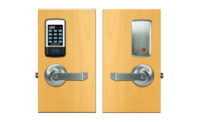Electronic Access Provides Versatile Security Solution for Arizona Autism School

Diana Diaz-Harris, founder and executive director of Arizona Autism Charter School Inc. (AZACS), was on a mission to create a cutting-edge school exclusively to educate students with autism and related disorders.
“I have a child with autism, and I had trouble finding a school,” said Diaz-Harris. “Typical public and private schools were not able to meet his needs. With the support of parents, grandparents and a wide range of professionals, I envisioned a school that would be results driven for kids no matter where they fall on the autism spectrum.”
Located in Phoenix, AZACS opened in 2014 as Arizona’s first tuition-free, public charter school focused on students with autism spectrum disorder. It has since become an international model on best practices to help all students become more engaged with learning.
AZACS moved into a new state-of-the-art facility, which was constructed as its “dream school,” in 2020. The building is an abandoned art gallery that was gutted and rebuilt to help AZACS push the boundaries of education. The school had purchased all doors, frames and locks, but hit a barrier when it wanted to install electronic access.
“This school is cutting edge and innovative in everything we do,” said Dan McCarty, AZACS operations and IT director. “From a security standpoint, we needed an electronic lock solution that would allow us to give and take access hourly or daily to accommodate both the educational needs of our students and the observation needs of our researchers. Our researchers are typically in special research hubs where they can see the students without disturbing the classroom environment. We hit a point of no return to run cabling and had to figure out a way to add wireless electronic access.”
A subcontractor suggested dormakaba’s BEST Switch Tech Platform, including the Switch Core lock, which offers a digital replacement for mechanical small format interchangeable cores (SFICs), and arranged a demonstration.
“Switch Tech was exactly the kind of product we were looking for,” McCarty said. “It’s an innovative, cutting-edge system. Competitive products require cabling or have a short battery life. Switch works everywhere and has the ability to scale and expand as we do. We can keep adding it to new doors and it won’t be difficult to put into our system.”
AZACS uses Lenel OnGuard access control, which directly integrates with Switch Tech software to provide a seamless end-to-end solution. To date, 60 Switch Tech cores have been installed on classroom, research hub and administrative office doors across the campus area and a cabinet in the nurse’s office. McCarty is able to control access and track who enters and exits. He has plans to install additional cores as AZACS grows.
“I communicated my vision to Dan about the research hubs,” Diaz-Harris said. “I wanted them to be able to be accessed by researchers, speech therapists, occupational therapists, program managers and all professionals who help kids. I also wanted a full transparency model where parents can come in and observe. This requires different levels of access to different rooms. Dan researched this technology and was able to make this vision a reality.”
McCarty uses the Switch Tech admin tool on his phone to access information and stats via the app. He can also grant or deny access from the field quickly, an important necessity since he moves across all parts of the AZACS campus frequently and is rarely in his office.
“It’s good to get tracking information and change credentials on the fly,” McCarty said. “It’s been pretty seamless.”
The Switch Tech platform extends electronic access control to applications previously not practical. Switch Core will work wherever SFICs do, including cylindrical, mortise and other locks by BEST, Sargent, Yale, Corbin Russwin, Schlage and more. It is ideal for retrofitting electronic control into existing doors on interior rooms, closets, cabinets, and cases. Installation takes just minutes and requires only a changeout of the existing core to Switch Core.
Switch Core operates using secure Bluetooth technology. Users simply unlock the core using their smartphones or fobs, instead of a mechanical key.
“I have two support staff,” McCarty said. “They’re young IT guys who love tech innovations. They’ve found Switch really easy to pick up and use. They especially like that they can see inside the lock when they change the battery. This is so much better than a key system. Keys are easily lost, and it becomes expensive and time prohibitive to replace keys or rekey locks.”
McCarty had two initial safety concerns.
The first was whether Switch Tech could hold up to rigorous bumps from AZACS students?
“Our students may bang into things a little harder than in other schools,” McCarty said. “I needed to make sure that this lock could handle a good hit. Our salesperson assured me the lock was tough, but I quickly saw for myself the truth of that. I’m really pleased with the strength of the lock itself. It can take a hit and still work just great.”
But how would Switch Tech handle lockdowns if an intruder were present?
“If a bad person gets in here, I want to be able to lock everything down,” McCarty said. “This device is already locked down. Access is tight and you have to let someone in if they don’t have credentials. I know where every fob is. A stranger can’t just pick up a fob and use it. I don’t have to know where every key is any longer like you do with a traditional key system. That’s an incredible ability to alter how we let people in and out of rooms.”
For more information, visit www.timeforaswitch.com.
Looking for a reprint of this article?
From high-res PDFs to custom plaques, order your copy today!







